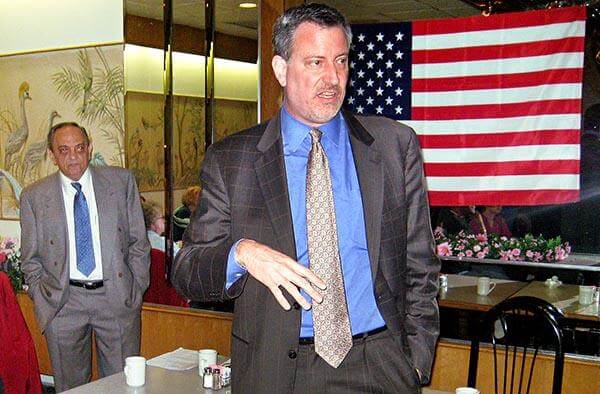By Connor Adams Sheets
City Public Advocate Bill de Blasio brought his vision of a New York City government that treats all five boroughs as equal to the Queensboro Hill Civic Association last week.
Speaking before a full house at the Palace Diner, at 60-15 Main St., de Blasio, the second-highest-ranking city official, discussed ways for improving how the city is run and answered residents’ questions and concerns during an appearance March 30.
A former Brooklyn councilman from 2001-09, de Blasio said he sympathizes with Queens residents who believe Mayor Michael Bloomberg’s administration focuses most of its attention and resources on issues in Manhattan, shortchanging the other four boroughs.
One time that inequity had significant importance for residents of both Brooklyn and Queens, de Blasio said, was the city’s response to the Dec. 26, 2010, snowstorm, which Bloomberg himself described as “inadequate” and “unsatisfactory” and which left many streets uncleared throughout Queens and Brooklyn for days after the blizzard hit.
“At times Bloomberg was talking about the Bronx and Staten Island and Queens and Brooklyn as if they were foreign countries. The attitude and the assumptions were the underlying issue,” de Blasio said. “We learned about the inability and unwillingness of the city to try a five-borough strategy.”
De Blasio, who serves as a watchdog over city government in his current role as public advocate, also commented on the city and state’s budget issues and offered his opinions on choices state leaders made in recent weeks to reduce deficits.
“In Albany, what happened in the last few days may be the beginning of some real change,” he said. “In the short term, there will be some real pain … but someday we’ll probably say that this was a turning point and a point when the state finally got its act together.”
He said the city now needs to make tough choices about its own budgetary priorities and the first step is to decide which areas are off limits for cuts, then make decisions about what to cut based on remaining resources. He laid out his vision for the budget, admitting it will be difficult, but suggesting what must be preserved.
“Keep the level of policing we have now, don’t close firehouses, and keep the level of teachers we have now,” then look at where costs can be trimmed, he said.
He also answered a number of questions from the Queens residents, instructing them on how to go about getting enforcement for idling buses and cars, and discussing how to fix the problem of children who must take long journeys across the city to get to class when there are good schools in their neighborhoods.
But he would not commit on one of the biggest questions many have for the top official: Will he run to replace Bloomberg in 2013?
“It’s very flattering, and the day will come when we’ll all have to figure out what we’re going to do after Michael Bloomberg ceases to be mayor, and I’ll make those decisions at that time,” he said.
Reach reporter Connor Adams Sheets by e-mail at csheets@cnglocal.com or by phone at 718-260-4538.

































